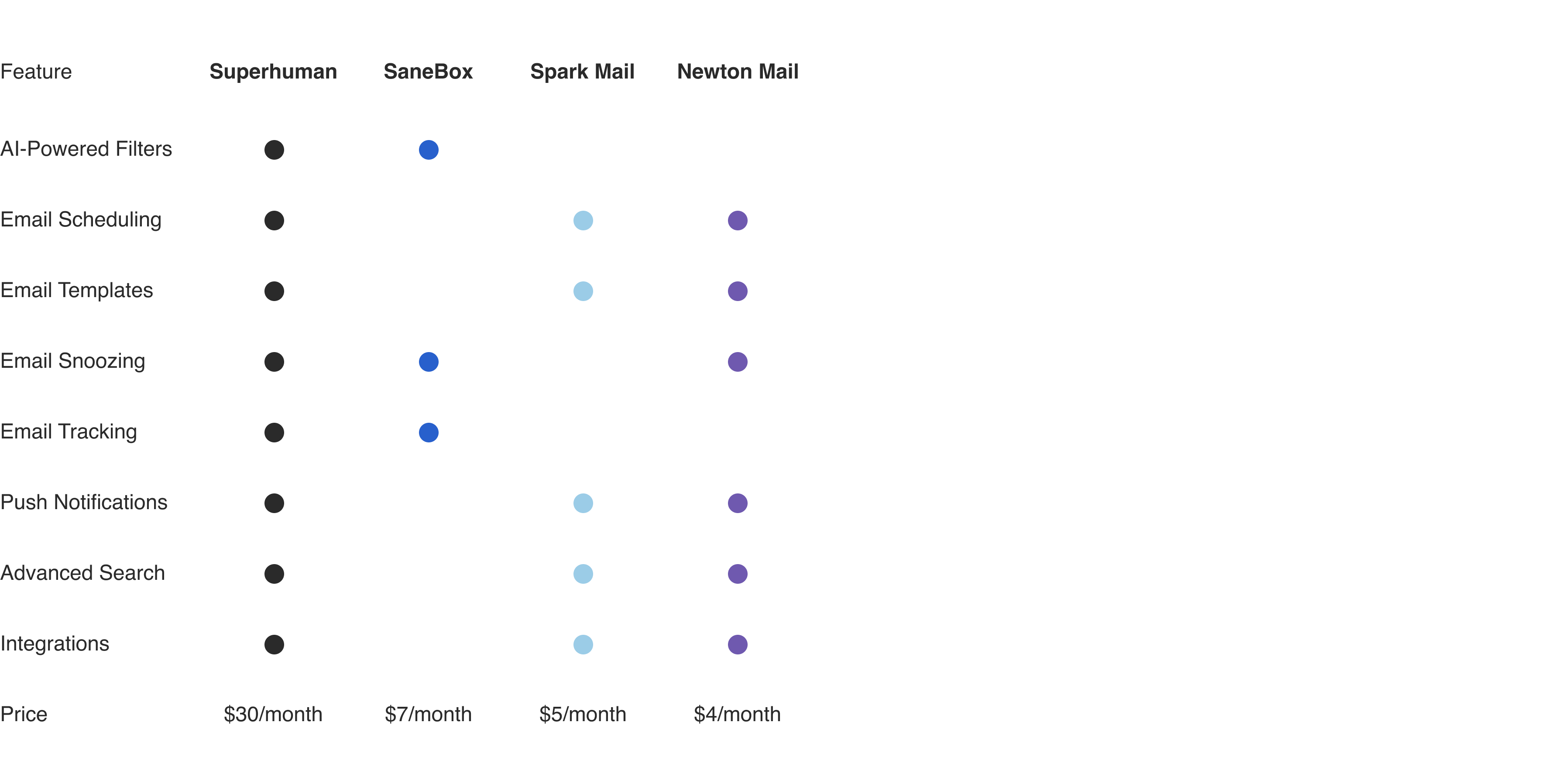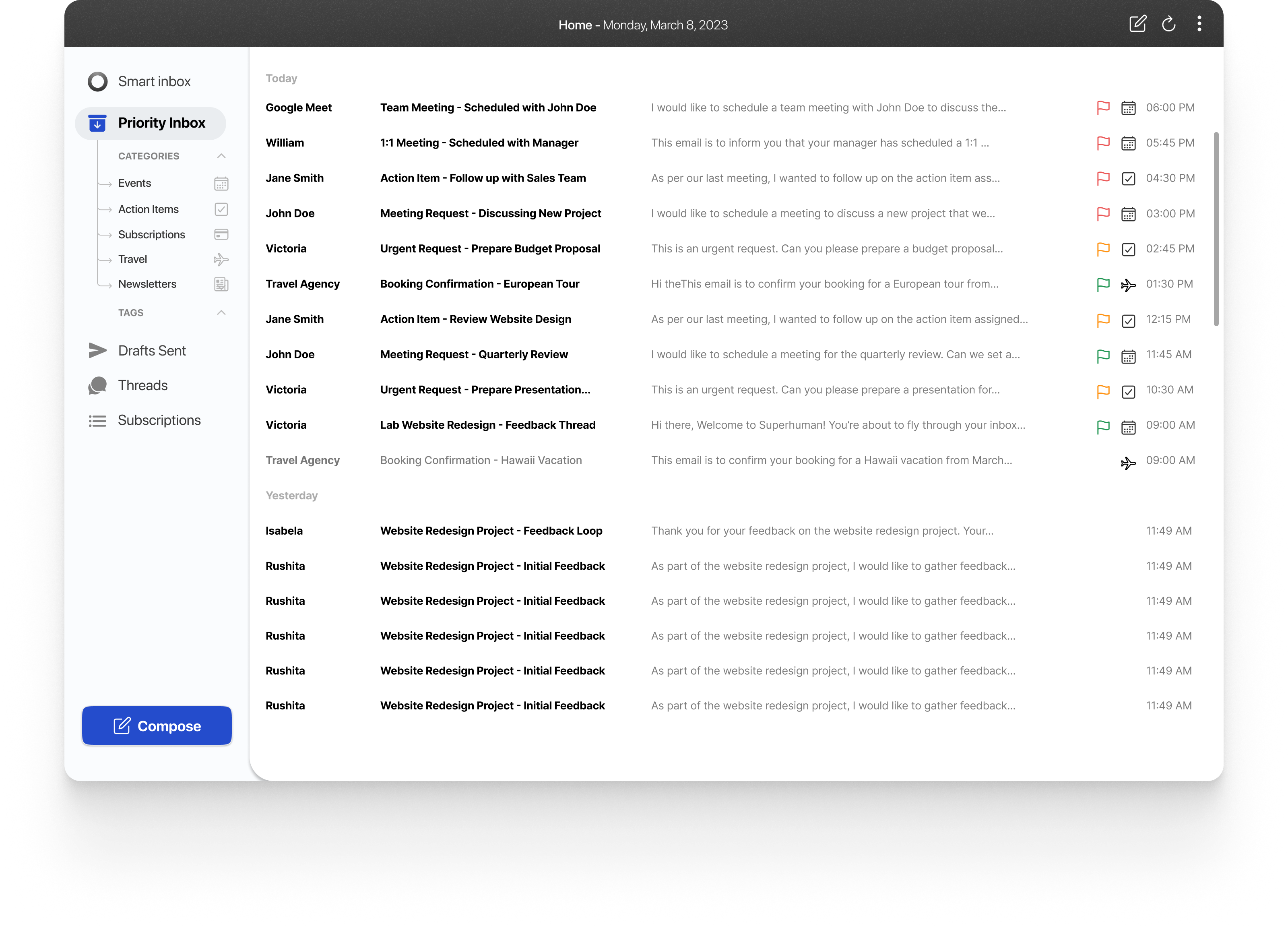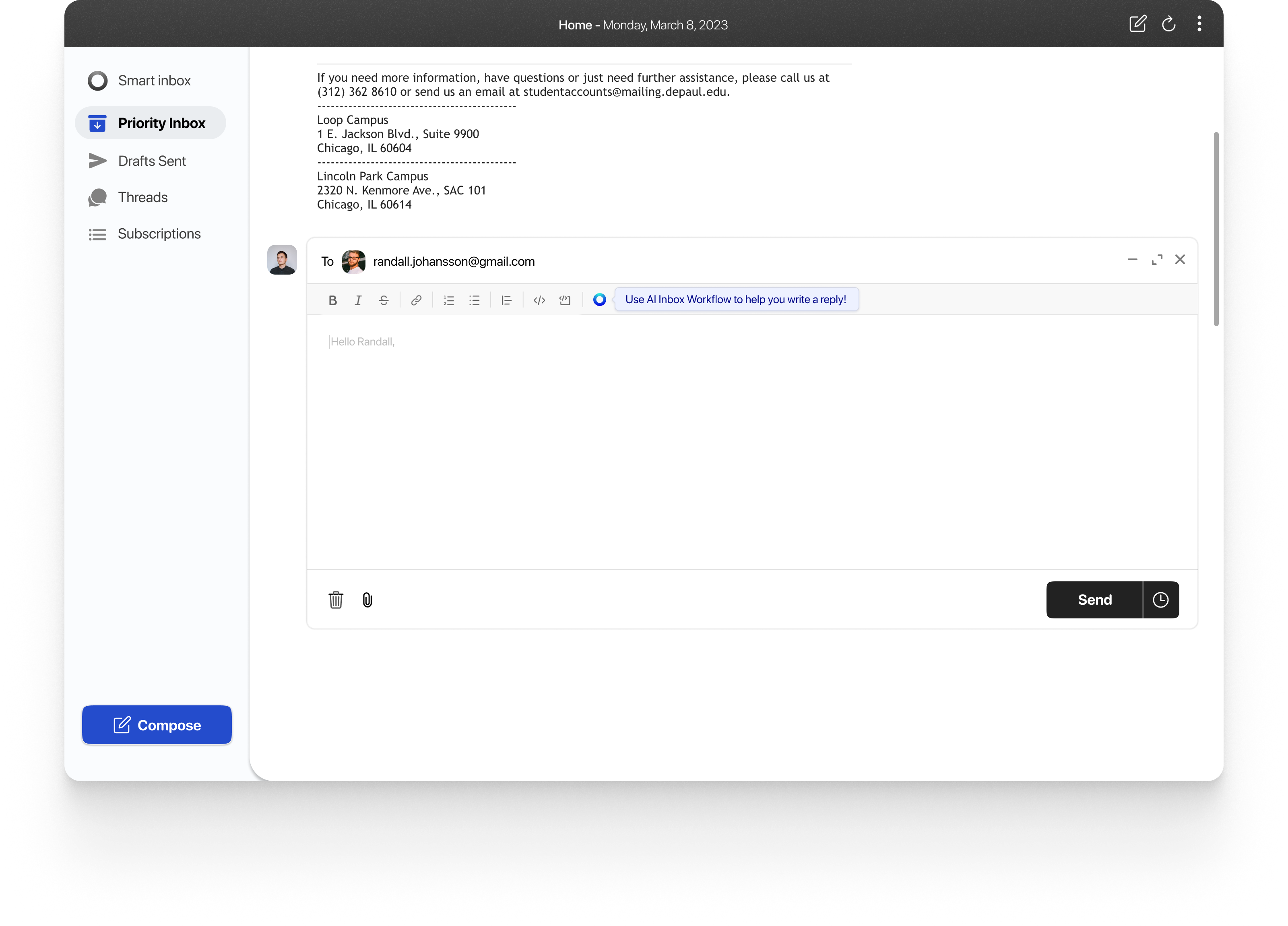AI Inbox (In Progress)

Type
Group Project
Method
User Interview
Cognitive Walkthrough
Usability Testing
Prototypes
Tool
Figma
Duration
Jan 2023 - March 2023
Paving the way for a more organized email management experience.
Introduction
Despite the incredible leaps in technology we have made, email has remained largely stagnant. Juggling emails can be an exhausting and time-consuming activity for professionals. Yet, with Artificial Intelligence at our disposal, we are positioned to revolutionize how people manage their inboxes, forever changing how they interact with their messages. We are driven to revolutionize the email experience by introducing AI Inbox, a groundbreaking tool that personalizes and streamlines communications. With voice technology, users can seamlessly interact with our app in an organic way, transcending traditional human-computer interactions into something far more intuitive. We face a huge challenge: paving the future of email management and setting new standards for how people stay organized online.
For busy professionals, freelancers, and remote workers wanting to maximize their email organization, AI Inbox is the perfect solution. This cutting-edge tool employs both artificial intelligence and voice technology for a personalized experience that includes automated sorting, smart replies, summary views, plus voice commands, enabling custom settings like filtering or translation with ease. AI Inbox stands out among the rest due to its highly advanced Artificial Intelligence-driven features like automated categorization, voice composition command ability, and translation. Not only that, but it also gives helpful auto-reply options and AI summaries for convenience. Furthermore, there are added safety protocols as well as personalization choices to arrange your workflow with enhanced efficiency levels. Additionally, it offers a powerful NLP-based keyword search feature that helps users quickly locate emails or specific information within them, thus distinguishing itself from its competitors in the market.
Goals
1. Developed a solution to increase user productivity by reducing the time spent on managing emails.
Measure: Estimate the amount of time saved on email management before and after utilizing AI Inbox to determine its effectiveness.
2. To enhance the precision of automated labeling and organization of emails.
Measure: Utilize the AI Inbox tool, take note of how many emails were incorrectly identified or sorted before and after implementation.
3. Streamlining the response time for emails.
Measure: Compare the average amount of effort and time spent on composing and sending emails before and after introducing AI Inbox technology to measure our progress.
Research Methods
.Competitive Analysis

.User Research Interview
A. Goal
To determine user perception of the current email communication system, their wants, and needs, as well as any issues they may face, we are conducting a survey to gain insight that will shape the AI Inbox tool.
B. Explaination
An interview can be tailored to participants' experience and background, leading to a more open and concise response.
C. Detailed Method Description
We conducted our interview through Zoom. We recruited five participants, two identified as female and three as male. After introductions and acquiring informed consent, we started by asking questions regarding the participants' experience using email. Then identified the common action for our following design.
.Cognitive Walkthrough
A. Goal
To validate the design of AI Inbox and collect feedback on its usability and efficacy, we need to assess it so that our final product is improved.
B. Explaination
C. Detailed Method Description
The participants performed two tasks regarding managing and composing emails on our prototype, then used the cognitive walkthrough worksheet to see if the tasks met the criteria. We then modified the prototype based on the feedback and suggestion.
.First-click Testing
A. Goal
To evaluate users' data, feedback, and how they apply the knowledge to our AI Inbox tool's automated sorting, categorization, and filtering features for optimum performance. With this information, we can improve design decisions over time.
B. Explaination
After the user research interview, we discovered two main themes aligned with their needs-categorization and compose/reply, we designed the email functions for users' needs to help email users manage and respond to emails.
C. Detailed Method Description
We conducted the first-click testing through the Optimal workshop to evaluate how users navigate the workflow of the “Daily Summary” and “Draft Email Template” tasks.
Result
.User Research Interview
The user research interview method includes screener questions, introduction, warmup questions, main questions, and demographic phase. Through interviews, we discovered that most participants find automated categorization and suggested responses helpful. And need help with prioritizing emails and lack of time to respond to emails. Therefore, our following prototype design focus on developing a manage emails solution, labeling and categorizing emails, and streamlining the response time for emails.
.Cognitive Walkthrough
The cognitive walkthrough method allows the prototype to be examined from the users' perspective and provides feedback by performing tasks. For the “Find a summary of important emails” task, users did not have a major usability issue; however, the measurable outcome and how it differs from other products are unclear. Therefore, to enhance the "Find a summary of important emails" task, we incorporated AI-powered algorithms for a personalized and relevant summary, aiming to differentiate our product from competitors and provide measurable outcomes. Moving the daily summary to a separate Smart Inbox page and adding productivity statistics improved overall usability and effectiveness. A clear dashboard, like home organizes information and reduces clutter on the main page, allowing users to focus on their email tasks. These enhancements set our product apart from competitors, improved user satisfaction, and made the AI Inbox prototype a more effective solution for email management. For the “Draft an email to request cancellation of a service” task, users were unclear about the relationship between each dropdown selection and how to exit the AI Inbox workflow. Therefore, we designed to generate dependent options after the previous selection is made and added a leave AI Inbox button to enter and exit the AI Inbox workflow function clearly.
.First-click Testing
The first-click testing method helps analyze users' clicks and time spent on finding the initial click of the tasks. We recruited 19 participants to perform the “Daily Summary” and “Draft Email Template” tasks, and ten of them completed the tasks. The participants took a median time of 08:36 to complete the study. The “Daily Summary” success rate is 70%, and the average time taken is 12.56 sec. The “Draft Email Template” is 80%, and the average time taken is 12.12 sec. Then we modified the prototype based on the test result by increasing the element visibility and simplicity.
High-Fidelity Prototype
After receiving feedback from usability testing, our team made improvements and fine-tuned the high-fidelity prototype.
.Automated labeling and organizing email

.Composing email

Discussion
A limitation of the project was a relatively small sample size and the information architecture research. Additionally, the limitation of applying functional AI features to test the difference between performing a task as usual and using the AI Inbox tool. For future work, we recommended exploring users' cognition on the information architecture categorization and the potential opportunities for applying functional AI features.
One thing that could have been done differently is to recruit more participants for the first-click testing method to obtain a more comprehensive understanding of users' behaviors and preferences. Additionally, the team could have explored other methods, such as A/B testing or usability testing, to gather more in-depth feedback and improve the prototype further.
The positive outcomes of this project point to the tremendous potential of utilizing AI-driven algorithms and machine learning techniques in email management systems, leading to improved user productivity, efficiency, and satisfaction. Additionally, it emphasizes the significance of taking into account users' needs and wants when designing a product for optimal effectiveness as well as usability.
The potential of the AI Inbox prototype is immense and can be further expanded by incorporating voice control, natural language processing, and interoperability with other popular tools. Additionally, exploring how this revolutionary prototype could benefit team collaboration or project management in various contexts would yield great results.